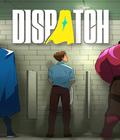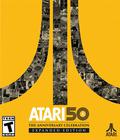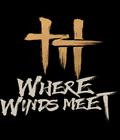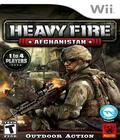Heavy Fire started out as a simple WiiWare game that felt like a throwback to the lightgun era. The first game, subtitled Special Operations, didn't feature the greatest graphics, and it didn't revolutionize the genre, but it was quite fun, especially when you factored in the cost of downloading the game. A year later, the sequel Black Arms featured the same type of action with the same price but in a different setting. It was still a fun game, pleasing fans of a genre that is finally seeing a renaissance of sorts. More than six months after the release of that title comes Heavy Fire: Afghanistan, which represents a few firsts for the series. This is the first game that has seen a retail release instead of a digital one. However, just because the latest game in the series costs four times as much as the other entries doesn't mean that it is that much better.
The plot is probably too simple for some. You play as a soldier who knew he wanted to be a Marine since the age of seven. Right after high school, he enlisted and is now part of the force, engaging in missions against terrorists in Afghanistan. That's really all there is to it. There's no ultimate boss to fight, no larger mission to stop, none of the standard tropes one would expect from any shooter. For some, it may be refreshing to not have to worry about a crazy story that tries to flow like a movie, but for others, having no overall point makes the purpose futile.
Like the plot, the gameplay is also rather straightforward as it adheres to typical lightgun shooter mechanics. You'll shoot at enemies while taking care not to shoot at friendly forces. While most items in the environment are indestructible, you can still shoot out some signs, jars and boards as well as pick up health packs and other items from the field. You will carry a machine gun at all times with limited ammo, and once you run out, you'll whip out a pistol that has unlimited ammo but needs to be constantly reloaded. At the end of each level, you'll be given a synopsis of how you did, including score and accuracy. Like any lightgun shooter, this is all standard fare.
Despite this, the game tries to do a few things differently across the campaign's 12 levels. Taking a page out of the Time Crisis series, Heavy Fire: Afghanistan lets you enter cover once you are positioned. Unlike that game, though, you'll have two or three areas to take cover instead of just one. You also have two different guns in your arsenal, the standard machine gun and the pistol, which has unlimited ammo. There's a leveling system in place, where snagging trophies helps increase your character's rank and lets you upgrade things like faster reload time, carrying capacity for ammo and grenades, more health, and a better machine gun. Finally, the game sports a second difficulty level once you finish it. It makes the game more difficult and changes around the environment a bit.
Unfortunately, the game does a number of things to dampen the experience. Even on the hardest difficulty level, most of the enemies seem to have a tough time actually hitting you. There is an exclamation mark over an enemy's head to let you know that his shot will finally meet its target, but that only seems to be important when facing off against large groups. Oddly enough, these enemies have a better tendency to hit you on the Wii version than on the PS3 version, making this game only a little tougher than expected. While you have two guns with you at all times, you can never switch them at will. You always have to deplete your ammo reserves on the machine gun before you can switch to the pistol, and you'll always revert back to the machine gun once you obtain ammo for it, making for a pretty inelegant system if you accidentally hit the ammo crate.
There are times when the cover isn't foolproof. In more than a few situations, you only have one piece of cover available, but going to it doesn't completely protect you from enemies. This wouldn't be so bad if you can fire back from cover, but there are times when this doesn't work, as shots that seem to go through end up hitting the walls instead. Finally, while the presence of your soldier's hand and gun are nice, they end up being obstructions when you're viewing the shooting space. It gets much worse when you're placed in a helicopter since your view is completely inside the cockpit, forcing you to spray and pray instead of firing more calculated shots.
Heavy Fire: Afghanistan supports several different control schemes, but none of them seem very different. No matter what method you choose, some functions are always in the same place. The B button fires shots from your gun while the A button performs a reload. Moving the controller in an indicated direction when instructed feels more responsive than the PS3 version, as it reads the actions almost immediately instead of with some lag. Hitting the 1 button throws grenades or uses missiles or tank shells when you're in those vehicles, though one might forget that these functions are there since the button isn't exactly easily accessible. When using the Wii Remote only, you can enter cover by hitting any direction on the d-pad but, like the 1 button, its placement doesn't make it easy to quickly get behind cover. If you're using the Nunchuk instead, you can enter cover by using the analog stick. The extra buttons afforded by the attachment only mimic the A and B buttons on the remote, though, so those hoping to throw grenades with a more accessible button will have their hopes dashed.
When going from the PS3 to the Wii, one expects there to be a graphical downgrade. No one would have expected the downgrade to be this drastic, though. Bloom lighting is gone, but there seems to be no attempt at any sort of shadowing. A scene is either very bright or slightly dark, but there's no level in between. Character detail was never strong on the PS3 version, so the downgrade isn't too noticeable here. What is noticeable are the environments, which took a major hit. Textures are blurry, and environments appear with more graphical seams and fewer polygons. The mountains in the opening scene of the first level, for example, have angles sharp enough to make it look like it came out of a PSOne game. The environments also got some other small changes, like closed doors and missing vehicles and signs in some places. All of this makes the Wii iteration look dramatically inferior.
The sound ranges wildly between serviceable and bad. The music isn't that bad, as it tries to evoke the same vibe heard throughout most action movies and games. It's not memorable material, but it works well enough as background music, though the title screen and menu music can be grating once the vocals kick in. The voice actors sound bland. Your character sounds like he's bored, and the dialogue doesn't sound authentic or exciting. When stating the time, he uses the 12-hour clock instead of military time, so it's 8 PM instead of 20:00. Everyone else has the same tone of disinterest and repeats the same lines over and over again when not in a cut scene. There can only be so many times when a fellow soldier tells you to shoot a truck or get the ammo on the ground before you tire of it. The sound effects sound bad. The explosions don't sound as loud as one would expect, and all of the gunfire sounds distant and muted. Your pistol sounds like it has a silencer on it although you can't see it, and all enemy gunfire sounds small and distant even when enemies are very close to you. It's bad enough that you'd rather turn up the music and voices just to drown out the effects.
As stated before, there doesn't seem to be much justification for the price hike in Heavy Fire: Afghanistan. The game may let you have four players playing together, but it does so with a package that looks and sounds merely serviceable. The gameplay is decent, but for something so simple, it is outclassed by the system's other lightgun shooters, including its predecessors in the series. Going with either one of the WiiWare games would be a better investment over this game, which simply feels like a WiiWare game on a disc. The only reason to consider purchasing this is if you've somehow gone through all of the lightgun shooters on the Wii and still crave something new.
Score: 5.0/10
More articles about Heavy Fire: Afghanistan











 Heavy Fire: Afghanistan is a super fast-playing, high-intensity military action experience set in modern-day Afghanistan.
Heavy Fire: Afghanistan is a super fast-playing, high-intensity military action experience set in modern-day Afghanistan.






